Zelda Dungeon’s Blossom Tales II: The Minotaur Prince Review
Posted on August 23 2022 by Andy Spiteri
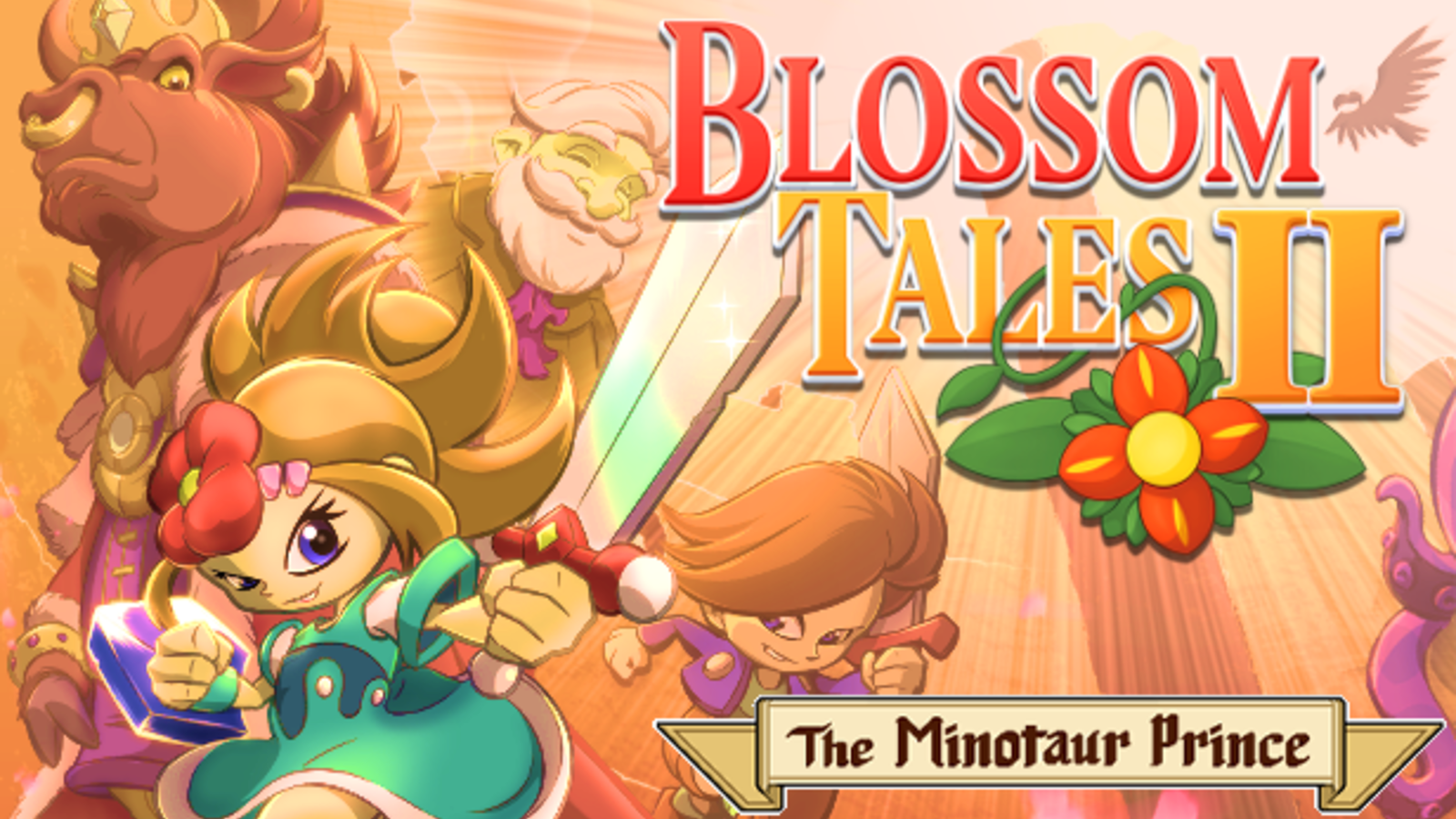
When it launched back in 2017 for the Nintendo Switch, Blossom Tales: The Sleeping King quickly became one of my favorite titles of the year. There was something about it that, in a year full of reinvention and new concepts for Zelda with Breath of the Wild, felt so familiar and charming to me. Nostalgic even. This was an adventure that wore its inspiration on its sleeve and fit right in with the classic 2D, top-down Zelda games of years past. At the time, I wrote that with Breath of the Wild’s massive success and no secondary portable console anymore, I wasn’t sure what the future of these top-down Zelda games would be (which, by the way, five years later rings true, as we haven’t had a new Zelda game in that style, remakes aside) and that games like Blossom Tales might be the future for fans of that particular style of Zelda game.
So it was with baited breath that I waited and waited for a sequel to The Sleeping King. It took a long time, but Blossom Tales II: The Minotaur Prince has finally arrived in the nick of time for Zelda fans, and fortunately, the game is exactly what you’d expect. Zelda-like titles have come a long way in the last five years, though—does Blossom Tales II keep pace with its contemporaries and manage to bring something fresh to the table? Or does this sequel suffer from the common sophomore slump? Let’s unpack everything we need to know about Blossom Tales II to decide if it’s worth your rupees!
If It Ain’t Broke, Don’t Fix It
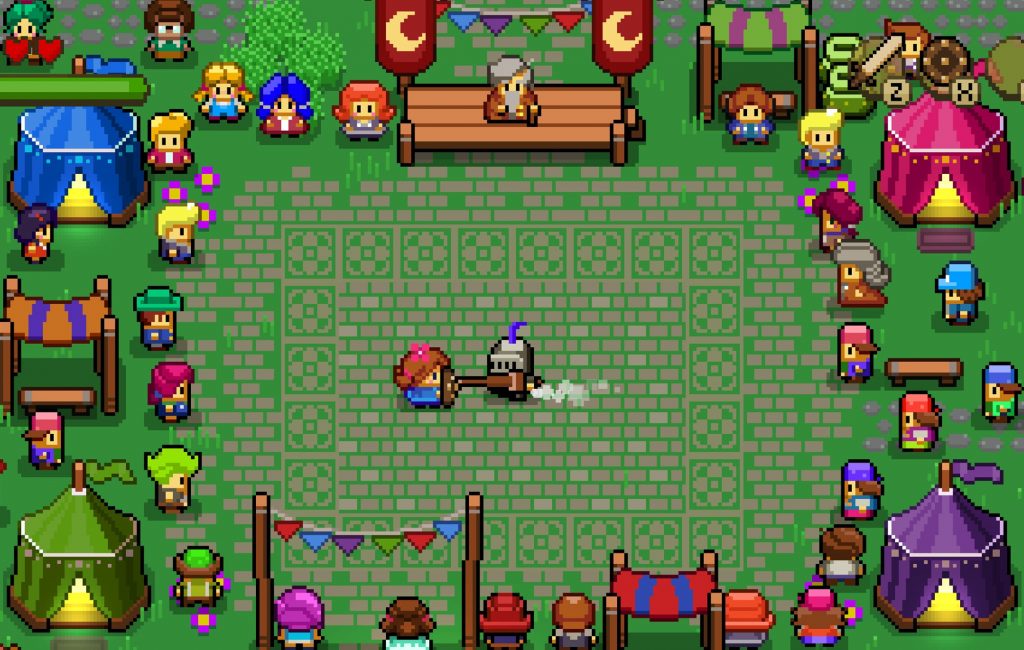
The good news is that if you’ve ever played a top-down Zelda game like A Link to the Past or Link’s Awakening, you will immediately be at home controlling Lily throughout her adventure. The first Blossom Tales largely took a “if it ain’t broke, don’t fix it” approach in terms of how the game would be controlled, and the sequel by and large sticks with that attitude. You’ll be swinging your sword at enemies, traversing a segmented world map, using familiar items like the Bow and Hookshot, and doing, well, a lot of top-down Zelda stuff like fishing, playing music, and more. It’s simple, although I could make an argument that it might be too simple. Yes, there are a ton of secrets to find and collectibles to acquire (more on that later), but in terms of some kind of gameplay hook or gimmick, there’s really nothing to sink your teeth into beyond controlling a really fun 2D Zelda-like game. While that sounds like a compliment (which it mostly is, by the way), we’ve seen the last several top-down Zelda games offer a compelling gimmick (think the dual worlds of Oracle of Ages or The Minish Cap, the wall merging from A Link Between Worlds, etc.) to give those games a little spice, something that The Minotaur Prince decides to forgo in order to keep things simple. To be clear, there’s nothing wrong with that decision, and I’m not going to complain about a game that controls as nicely as Blossom Tales II does, but I also have to admit that I found that kind of simplicity more charming in the first Blossom Tales game, whereas with the sequel, I was craving more of an advancement.
Combat is an area that could have used the kind of advancement I just mentioned. Fighting in Blossom Tales II is as simple as swinging your sword, charging up a spin attack, and using items. It’s the classic Zelda formula, no doubt, but in an era where contemporary titles like Tunic and Death’s Door have incredibly precise dodges players need to make, customizable weapon loads, or hit-boxes that require you to make the right move at the right time, The Minotaur Prince’s combat can feel a bit… lackadaisical at times. Even compared to some Zelda games, Lily’s sword strikes can feel a bit soft and slow; for example, when the player is rapidly pressing A to make Link swing his sword, Link swings that darn sword at a lightning speed, enough to destroy any blocks or creatures flying at you, whereas Lily’s sword strikes take longer to connect, particularly when you get to the third part of her hit combo when she starts to do a twirling spin attack. There were a couple times where I walked into an enemy and took damage while I was pressing the strike button simply because Lily was facing the wrong way, in the middle of her spin combo. It’s a little thing, but one that stuck out to me. Although you can find scrolls to upgrade your combat abilities (think the dojo’s from The Minish Cap), I don’t think those really augment the combat enough to say it’s a strength. On the plus side, the game does allow you to keep your momentum and doesn’t have Lily stop in her tracks to strike, which is always a welcome benefit.
Another area that we’ve seen modern Zelda-like games like Tunic or Anodyne make advancements in is letting players decide what order they want to accomplish their goals in. Heck, we’ve seen A Link Between Worlds embrace this concept as well. Blossom Tales II, however, has you on a set path, doing one area first, the second area second, etc., which feels like a missed opportunity. While the pacing of Blossom Tales II is certainly fine, and the story beats as you progress along the way make sense, there is that element of freedom that seems missing. Some of the other games I mentioned will encourage you to start in particular areas, but not force you to, and since The Minotaur Prince has the familiar “go to three dungeons and collect <insert item>”, I see no reason why that kind of approach couldn’t have worked here.
On the plus side, the world of Blossomdale is full of incredible color and personality, making the ~15-20 hours you’ll spend traversing the map a visual joy to behold. Blossom Tales II still uses the same charming 16-bit-style graphical presentation as the first game, though the world is even more varied and well developed this time. The sprite work is top notch, and every enemy looks memorable and unique. Over the course of your journey, you’ll travel through forests, beaches, lakes, deserts, haunted wastelands, and more, and each area feels like it has its own unique visual identity while still feeling connected as part of the overworld. The Minotaur Prince runs like a dream on the Nintendo Switch, too—in my 15 hours of gameplay, I haven’t noticed any significant frame-rate dips or lags in play, and I’ve encountered more than one area where the game will throw a whole screenful of enemies at you. Clearly, making sure the game runs smooth was a priority for Castle Pixel, and they accomplished that goal.
Dungeon Crawling
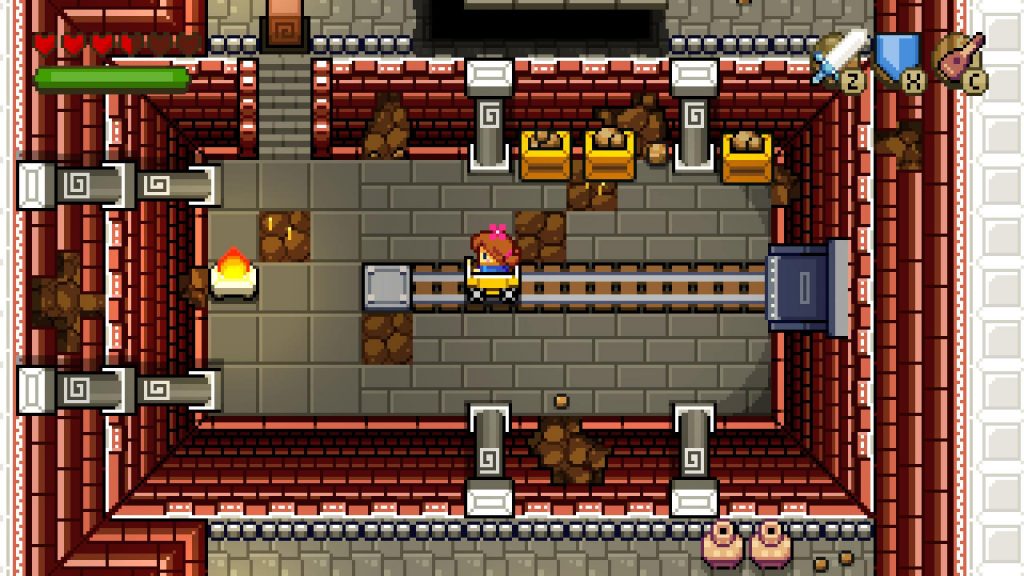
Of course, the real meat and potatoes of any good Zelda-like game is the intricate dungeons, challenging puzzles, and unique items, and in this regard, Blossom Tales II is solid if unspectacular. There’s nothing wrong with any of the dungeons or puzzles, but there’s also nothing really spectacular or noteworthy about them, either. I think the best description is that they’re enough. The dungeons all feel like a typical Zelda intro dungeon—simple, straightforward layouts designed to teach you how to play the game while offering a nominal challenge. This would be fine for the first dungeon (a cute little cave inside of a graveyard that houses your sword and shield), but they never really progress beyond that. While most 2D Zelda games will start you off on a more simple dungeon and gradually up the ante in terms of mechanics or intricacy, Blossom Tales II is content to present the same basic style of dungeon, differentiated only marginally by whatever quirks the area you’re in has to offer. For example, you’ll be raising water levels in one dungeon, but that certain aspect might be replaced with re-routing mine cart routes in the next. While the dungeons get progressively longer, they don’t get progressively more challenging. Again—it’s not like these dungeons aren’t fun or they’re not well made. They just don’t feel particularly ambitious.
You could apply that to almost all of the puzzles in the game too. There’s almost nothing you haven’t seen before in a Zelda game, and unfortunately, almost nothing you haven’t seen done better in a Zelda game to boot. There are some classics in here—block pushing, torch lighting, tiles on the floors, etc.—that will definitely require some thought, but the dungeons almost uniformly have the mentality of ‘solve puzzle in room, move on to next room, solve puzzle in room, move on,’ whereas we’ve seen the best 2D Zelda dungeons present overarching puzzles and layers to those puzzles that inform how you traverse the dungeon. Blossom Tales II chooses again to err on the side of simplicity (some would maybe call it accessibility), which is understandable, but disappointing.
The items are likewise exactly what you’d expect to see in a game like this. Bombs? Check. Bow and Arrow? Uh-huh. Shovel? Got it. Lantern? Yup. By the time that it was all said and done, there was only one item that we haven’t seen in a Zelda game before: a little gizmo that would let you drop a warp point, walk around, and press A to return to that point. Conversely, the puzzles that revolved around this contraption were the ones that stuck out to me the most. Not that having familiar items is bad, mind you (it does give you a sense of comfort and accessibility), but the items are just a little too on the nose for my liking. There are some exceptions, like having a yo-yo serve as the your Hookshot, which, while a small change, goes a long way it disguising how similar the items are, but Blossom Tales also can’t help itself in some respects, because when you do get (for example) a cool musical instrument that allows you to play songs and teleport and decide that you want your instrument to be a guitar—something cool and fresh—you’ll open up your menus to strum some tunes and see the exact same yellow c-button notes from Ocarina of Time, which again takes you out of the moment for a bit.
The game wisely takes the A Link Between World approach to using items, in that there’s no set number of bombs or arrows or whatever that you’re limited to, but rather your stamina will determine how many times you can shoot your bow or dig holes, etc etc. I loved this change in Link’s Lorule adventure, and I was happy to see this system used here. While unambitious, I don’t think what I laid out in terms of puzzles or gameplay will be a big issue for most players, and I also can’t sit here and say that it’s not fun either, but it would have been nice to see Blossom Tales try and forge more of an identity in this sequel. Instead, it seems like The Minotaur Prince has leaned into the idea of being an “Inspired By Zelda” title even more than it already had to define it.
Have You Heard The One About The Minotaur?
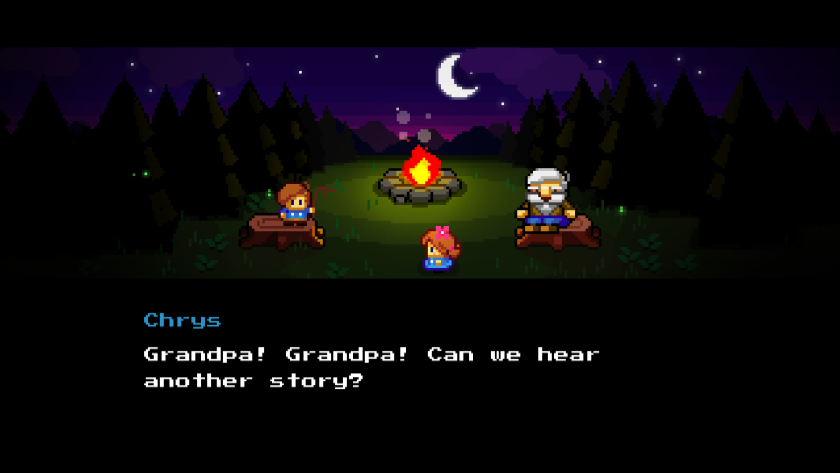
With The Minotaur Prince really sticking to the tried and true gameplay formula, it really needed its narrative, characters, and charm to help elevate it, and luckily, the story is up to the task. Blossom Tales II continues the unique story-within-a-story approach that the first game took, with Grandpa reading his grandchildren Lily and Chrys a story by the campfire. This allows for some interesting gameplay elements, since you can see speech bubbles of Grandpa, the real Lily and her brother in the “story world” of Blossomdale, and often, the kids will be squabbling about what they want to see out of the story (“I think Lily should fight pirates!” “no, she should fight ninjas!”) which lets you, the player, have the final decision and allows you to mold your adventure into something a little more unique. I don’t think this particular feature is used to its full potential, but it’s still a fun gimmick that has yet to wear out its welcome two games into this series.
The actual story of The Minotaur Prince is incredibly sweet and will instantly hit home to anyone that has a sibling. Lily and Chrys begin the game arguing in the real world, so Grandpa tells them a story of siblings who are also at odds in the fantasy world of Blossomdale. Lily and Chrys both live in Blossomdale, where there is an annual festival to celebrate the Minotaur King’s defeat many years ago. During the festival, Chrys cheats to beat Lily in a dueling contest, making him the champion. Angry and upset, Lily rashly wishes that the Minotaur King would come back and snatch away her brother. Be careful what you wish for, because next thing you know, the Minotaur King has returned and snatched away Chrys, taking him to his palace and making him the titular Minotaur Prince. Lily then goes on a journey to right her wrongs and rescue her brother. It’s a simple set up, but one that works really well, particularly with the not-so-one-dimensional King serving as a great villain for our heroes. Although you can probably guess where the story is going, the journey of Lily and Chrys is one filled with heart.
Lily herself is a more vocal hero this time around, having way more dialog and personality than I remember her having in the first game, which is always nice. Her brother Chrys is also a brat, albeit a lovable one, and the childish barbs and sibling dynamic between the two (both in the “real world” and in Blossomdale) are a highlight. Simple storytelling often yields the best results, and Blossom Tales II is a fine example of this in practice. The characters of the world are really fun, too, and help bring Blossomdale to life. From the weird guy who always wants to trade you things to the society of witches who teach you recipes along the way to the town full of off-duty enemies who just want to enjoy some downtime, Blossom Tales’s characters are consistently charming and reminded me in the best ways of some of the fun side characters that you meet in your journeys through Hyrule.
As you would probably expect, there are a ton of references to the Zelda series to be found. Without wanting to give too much away, I will say that there’s at least one gag that may or may not involve an owl that had me actually laughing out loud, and by starting the game with our heroes celebrating in a festival, it felt more-than-a-little like the beginning of The Minish Cap. For the most part, these references are subtle enough that they feel welcome, though there are some parts – specifically ones involving a legendary sword – that may make you roll your eyes a bit. Someone who worked on this game was clearly a Lord of the Rings fan as well, and I’m preeeety sure I saw a Metroid in someone house, so there’s lots of Easter eggs for eagle-eyed fans to keep an eye out for.
The Best of the Rest
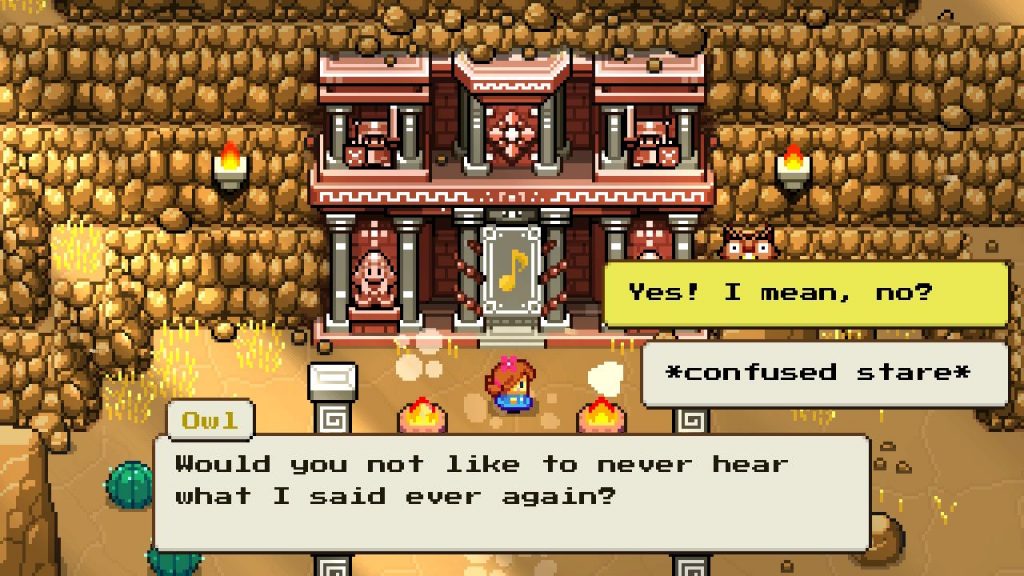
One area that Blossom Tales II excels in is making sure that you’re constantly busy on your journey. The game is absolutely chockablock full of things for you to do, from collecting fruits, to mini games, to delivering mail, to optional caves and mini-dungeons, so you shouldn’t find yourself bored. There are an absolute mammoth amount of heart pieces and stamina bits that you can find to fully upgrade yourself, as well as a collection of weapon upgrades that helps the combat pop a bit more. These are scattered throughout the world in the form of hidden caves and mini-games. While the mini-games certainly aren’t going to challenge you (like… at all), it’s still nice to be able to take a short break. Almost every area has a unique collectable for you to find (you’ll need to find 20 bones in the desert to complete a dragon skeleton, for example) which is a nice way to encourage players to just simply wander around and spend some more time in this charming world.
Of all the collectables, one of the ones I liked the most was collecting fish with my handy dandy fishing rod. Every good Zelda game needs to have a few moments of Zen where you can just cast a line, and Blossom Tales is no different. Fishing in this game is simple, fun, and can be done anywhere on the map, so while it’s not an original feature by any means, it was a welcome addition to this adventure. Also welcome is crafting. While The Minotaur Prince doesn’t go Breath of the Wild-in depth with its cooking mechanics, it’s still nice to be able to put all those random flowers and mushrooms you find to use in making potions that give you various buffs or abilities.
One area I haven’t spent much time on yet is the music, and truth be told, I don’t have much to say about it. You could probably apply what we said about the dungeons to the music: it’s enough. It’s definitely enjoyable while you’re listening to it, but I would also be absolutely shocked if anyone was able to hum a tune from memory. One area that Zelda really honed in on early on was its music; even if there weren’t very many tracks, it always seemed like each game had at least one standout that would stick with you, and I’m not sure Blossom Tales is quite there yet. Of course, music is probably the most subjective aspect of any game, so take that for how you will, but The Minotaur Prince’s soundtrack, while inoffensive, isn’t something that you’ll probably come away thinking about after your adventure is over.
Verdict

I almost feel a little guilty. In reading back this review, it might seem as though I don’t like Blossom Tales II, which couldn’t be farther from the truth, so I do want to say this plainly: if you are a Zelda fan looking for a Zelda-like adventure to hold you over, I can practically guarantee that you will enjoy Blossom Tales II: The Minotaur Prince. I’ve played about 15 hours and enjoyed my time a lot, and for the price of this game, the value that you get back is absolutely worth it. The world, the characters, the story, all these things feel so full of character and life, and when you combine that with the tried and true top-down Zelda formula, you have a winner. As a game that controls and moves and functions, this is a better title than the first Blossom Tales in basically every metric. That being said, I’d like to think that I was offering a bit of tough love, because I think that this series has some reflecting to do.
If there is to be a Blossom Tales 3—and I really hope there is—it needs to do something to forge its own identity. I’ve mentioned contemporary titles like Tunic, Death’s Door, and more in this review already, and what makes those Zelda-like games so great is that they take the best elements from Zelda and integrate them into their identity, whereas Blossom Tales has so far taken every element from Zelda and had that be its foundation—a fine enough foundation, but one built by someone else. The first game got by doing this largely on charm and nostalgia alone, but the second game suffers for it, and I worry that these diminishing returns would water down a third game to the point of redundancy. Blossom Tales II: The Minotaur Prince is a technically proficient game that will scratch the itch of Zelda fans, but by being so similar, it borders on forgettable.
An old adage that would serve Castle Pixel well to consider is that when offering a product that’s clearly modeled off something else more established, you have three options: you can be better than, you can be worse than, or you can be different than. Blossom Tales unfortunately will probably never be able to be better than Zelda, and as this review has pointed out, it’s not different than, so you’re only left with one option, and it’s the worst one.
I loved the first Blossom Tales. I really liked The Minotaur Prince, but I can’t say that I loved it.
Our Score: 7.5/10
Blossom Tales II: The Minotaur Prince was reviewed on Nintendo Switch, and is available for Nintendo Switch and Steam.
Review copy provided by Playtonic Games.

Andy Spiteri is a Manager of Zelda Dungeon, Host of The Zelda Cast podcast, and Owner of Omega Metroid. Probably drinking a Tim Horton’s Double Double as you read this.
Business: andy.spiteri@zeldadungeon.net



